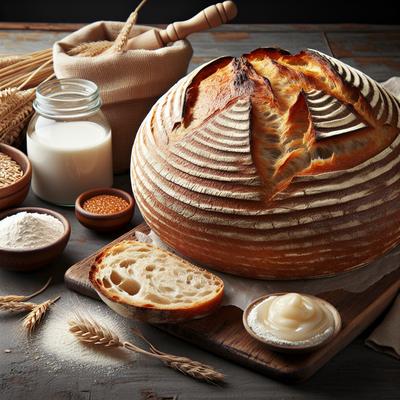Sourdough Bread Also Known As Grandma Angelitas Bread
Uncover the timeless charm of homemade sourdough with "Grandma Angelita’s Bread," a rustic loaf crafted with love and tradition. This recipe celebrates the art of sourdough baking, featuring a tangy, active starter, a blend of all-purpose and whole wheat flours, and a long, slow cold fermentation that develops complex flavor and a beautiful open crumb. The step-by-step technique includes stretch-and-folds to build structure, and shaping to create the perfect boule or batard. Baked to perfection in a preheated Dutch oven, the result is a golden, crackling crust that offers a satisfying contrast to the tender interior. Grandma Angelita’s timeless recipe is the perfect way to connect with heritage and elevate your at-home baking skills. Whether served as a hearty toast with your favorite toppings or a comforting side to soup, this sourdough loaf will quickly become a treasured staple.
Try SnapCalorie's FREE AI assisted nutrition tracking free in the App store or on Android.

Scan with your phone to download!

Ingredients
- 200 grams Active sourdough starter
- 450 grams All-purpose flour
- 50 grams Whole wheat flour
- 350 milliliters Water
- 10 grams Salt
Directions
Step 1
In a large mixing bowl, combine 200 grams of active sourdough starter and 350 milliliters of water. Stir until the starter is fully dissolved in the water.
Step 2
Add 450 grams of all-purpose flour and 50 grams of whole wheat flour to the bowl. Mix until just combined, forming a shaggy dough. Cover with a clean kitchen towel and let it rest for 30 minutes (autolyse stage).
Step 3
After resting, sprinkle 10 grams of salt over the dough. Gently knead the salt into the dough until fully incorporated.
Step 4
Perform a series of four to five stretch-and-folds over the next 2-3 hours. To stretch and fold, grab one edge of the dough, stretch it upward, and fold it over itself. Rotate the bowl slightly and repeat on all sides.
Step 5
Cover the dough and let it bulk ferment at room temperature for 4-6 hours, or until it has doubled in size. If your kitchen is cooler, it may take longer.
Step 6
Lightly flour a clean surface and turn the dough out onto it. Gently shape the dough into a boule (round loaf) or batard (oval loaf) by folding the edges inward. Use your hands to create surface tension on the dough by pulling it toward you as you shape it.
Step 7
Place the shaped dough seam-side up into a floured banneton or a bowl lined with a floured kitchen towel. Cover and refrigerate overnight (8-12 hours) for a cold fermentation.
Step 8
The next day, preheat your oven to 475°F (245°C) with a Dutch oven inside to warm up for at least 30 minutes.
Step 9
Carefully transfer the dough to a piece of parchment paper, flipping it out of the banneton so the smooth side faces up. Use a razor blade or sharp knife to score the top of the dough, creating a pattern or a simple slit for controlled expansion during baking.
Step 10
Using oven mitts, carefully remove the hot Dutch oven and place the dough (with parchment paper) inside. Cover with the lid and bake for 20 minutes.
Step 11
Remove the lid and bake for another 20 minutes, or until the crust is deeply golden and the bread sounds hollow when tapped on the bottom.
Step 12
Let the bread cool completely on a wire rack before slicing and serving. This step is crucial for the crumb structure to set properly.
Nutrition Facts
| Serving size | (1065.0g) |
|---|
| Amount per serving | % Daily Value* |
|---|---|
| Calories | 1907.6 |
| Total Fat 6.3g | 0% |
| Saturated Fat 1.1g | 0% |
| Polyunsaturated Fat 0g | |
| Cholesterol 0mg | 0% |
| Sodium 3955.7mg | 0% |
| Total Carbohydrate 399.7g | 0% |
| Dietary Fiber 20.3g | 0% |
| Total Sugars 1.2g | |
| Protein 55.1g | 0% |
| Vitamin D 0IU | 0% |
| Calcium 109.6mg | 0% |
| Iron 23.8mg | 0% |
| Potassium 724.9mg | 0% |
Source of Calories
